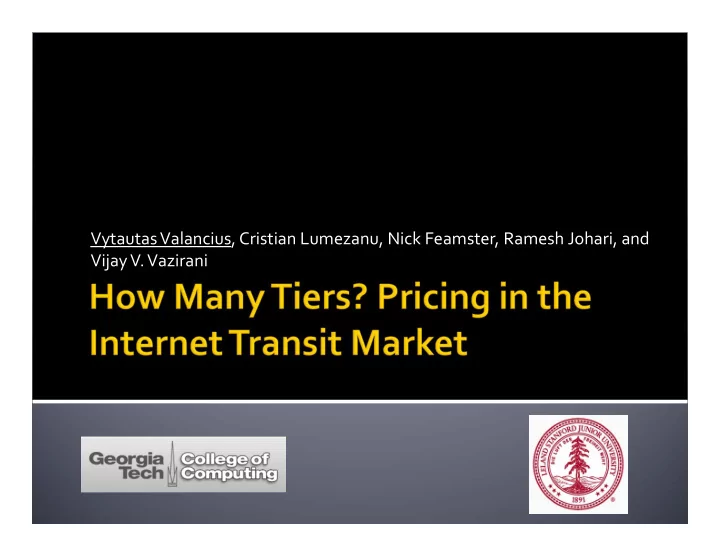

VytautasValancius, Cristian Lumezanu, Nick Feamster, Ramesh Johari, and Vijay V. Vazirani
Sellers Large ISPs Level3 National or international reach Buyers Traffic Invoice Smaller ISPs Enterprises CAIDA Content providers (CSUN) Universities Connectivity is sold at bulk using blended rates 2
Single price in $/Mbps/month EU Cost: $$$ Charged each month on aggregate throughput US Level3 Cost: $ Some flows are costly Some are cheaper to serve Price is set to recover total costs + Blended rate Price: $$ margin CAIDA Convenient for ISPs and clients (CSUN) Can be inefficient! 3
Uniform price yet diverse resource costs Clients ISPs Lack of incentives to invest Lack of incentives to conserve in resources to costly destinations resources to costly destinations Pareto inefficient resource allocation A well studied concept in economics Potential loss to ISP profit and client surplus Alternative: Tiered Pricing 4
Price flows based on cost and demand Regional pricing example: Some ISPs already use Global, Cost: $$$ tiered pricing Local Regional pricing Level3 Cost: $ Paid peering Backplane peering Price: Price: $$$ $ Limited number of tiers CAIDA (CSUN) Question: How efficient is such tiered pricing? Can ISPs benefit from more tiers? 5
How can we test the effects of tiered pricing on ISP profits? Construct an ISP profit model that accounts for: 1. Demand of different flows Modeling Servicing costs of different flows Drive the model with real data 2. Data Demand functions from real traffic data mapping Servicing costs from real topology data Number Test the effects of tiered pricing! 3. crunching 6
Profit = Revenue – Costs (for all flows) Flow revenue Price * Traffic Demand Traffic Demand is a function of price How do we model and discover demand functions? Flow cost Servicing Cost * Traffic Demand Servicing Cost is a function of distance How do we model and discover servicing costs? 7
Traffic Demands Current Prices Network Topologies Demand Models Cost Models Demand Functions Relative costs Profit Model 1. Finding Demand 1. Finding Demand Functions Functions 2. Modeling Costs 2. Modeling Costs Absolute costs 3. Reconciling cost 3. Reconciling cost with demand with demand 8
Price Canonical commodity demand function: Inelastic demand Demand = F(Price, Valuation, Elasticity) Elastic demand Valuation – how valuable flow is Elasticity – how fast demand changes with price Demand How do we find the demand function parameters? Valuation = F ‐ 1 (Price, Demand, Elasticity) Assumed range of elasticities Current price Current flow We mapped traffic data to demand demand functions! 9
Traffic Demands Current Prices Network Topologies Demand Models Cost Models Demand Functions Relative costs Profit Model 1. Finding Demand 1. Finding Demand Functions Functions 2. Modeling Costs 2. Modeling Costs Absolute costs 10
How can we model flow costs? � � � � Concave: Linear: � � � � � � � � Region: Dest. type: � � � � ISP topologies and peering information alone can only provide us with relative flow servicing costs . real_costs = γ * relative_costs 11
Traffic Demands Current Prices Network Topologies Demand Models Cost Models Demand Functions Relative costs Profit Model 1. Finding Demand 1. Finding Demand Functions Functions 2. Modeling Costs 2. Modeling Costs Absolute costs 3. Reconciling cost 3. Reconciling cost with demand with demand 12
Assuming ISP is rational and profit maximizing: Profit = Revenue – Costs = F( price , valuations , elasticities , real_costs ) F’( price* , valuations , elasticities , real_costs ) = 0 F’ ( price* , valuations , elasticities, γ * relative_costs ) = 0 γ = F ’ ‐ 1( price* , valuations , elasticities, relative_costs) Data mapping is complete: we know demands and costs! Subject to the noise that is inherent in any structural estimation. 13
Select a number of pricing tiers to test 1. 1, 2, 3, etc. Map flows into pricing tiers 2. Optimal mapping and mapping heuristics Find profit maximizing price for each pricing tier and 3. compute the profit Repeat above for: ‐ 2x demand models ‐ 4x cost models ‐ 3x network topologies and traffic matrices 14
Constant elasticity demand with linear cost model Tier 1: Local traffic Tier 2: The rest of the traffic *Elasticity – 1.1, base cost – 20%, seed price ‐ $20 15
Linear Cost Model Concave Cost Model Constant Elasticity Demand Logit Demand 16
Refine demand and cost modeling Hybrid demand and cost models are likely more realistic Establish metrics that predict the benefit of tiered pricing based on the observed demand and cost data Establish conditions under which demand and cost normalization framework works E.g., can we normalize cost and demand if cost is a product of the unit cost and the log of the demand? Test the effects of tiered pricing on surplus 17
ISPs today predominantly use blended rate pricing Our study shows that having more than 2 ‐ 3 pricing tiers adds only marginal benefit to the ISP The results hold for wide range of scenarios Different demand and cost models Different network topologies and demands Large range of input parameters The methods of finding demands and reconciling them with cost models might find uses outside profit analysis Questions? http://valas.gtnoise.net 18
Recommend
More recommend